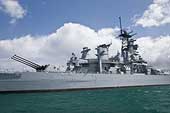
|
|
Download Options
| Image Name | Width x Height | Size |
|---|---|---|
| SIA2818.jpg | 640 x 441 | 48K |
| SIA2818.jpg | 1200 x 827 | 133K |
| SIA2818.jpg | 3504 x 2416 | 913K |
Caption
Japan's determination to halt the Allied advance during World War II is vividly reflected in the term "Kamikaze", or "Divine Wind".
Originally used in reference to the typhoon winds that destroyed the invasion forces of Kublai Khan, the term was resurrected in 1944 by Admiral Masafumi Arima who personally led the first Special Attack Force mission agains the Allies.
On April 11, 1945, during the allied invasion of Okinawa, a flight of 16 approaching Japanese aircraft was spotted by radar. Of those, one pilot set his sights on the American battleship Missouri and would not be stopped.
Coming in low off the stern, hit repeatedly by anti-aircraft fire and struggling to rise, the aircraft's left wing caught the side of the ship at the last instant and swung the "Zeke" hard against the hull, sending a fiery wave of debris onto the deck. The remains of the pilot was found among the wreckage.
Missouri's Captain, William Callaghan, ordered the burial of the unknown Japanese pilot the following day. A Marine honor guard fired a salute and his body was committed to the deep.
Between October 1944 and the end of hostilities in August 1945, some 3000 "kamikaze" sorties are estimated to have been flown.
The dents from the April 11, 1945 attack remain in the Missouri's hull to this day. This can be seen at about the center of the hull in this picture.